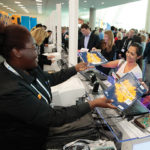
The March on Washington was all that Van White’s father used to talk about when Van and his siblings were young. Van was just a year old when the march took place, on Aug. 28, 1963. His father, Sam, was in college, and drove from Rochester, N.Y., to Washington, D.C., to participate in what would be one of the largest political rallies in American history, a gathering of several hundred thousand people that stretched from the Lincoln Memorial to the Washington Monument, and culminated with Martin Luther King Jr.’s “I Have a Dream” speech.
Eventually Sam White became an executive with the Xerox Corporation, one of the highest-ranking African Americans to hold such a position. And while he died 25 years ago, his son Van — a civil-rights lawyer in Rochester — never forgot how that march changed his father’s life. “So for me,” he said, “the goal was to give other people the opportunity to have that same sort of feeling, and ‘ also to hold up those people [from the 1963 march] who are still alive.”
With the 50th anniversary of the March on Washington for Jobs and Freedom (as it was officially known) this past August, White saw his chance. But another march wouldn’t be enough. “I wanted very much to have a march on the anniversary,” he said, “but I very much wanted to have it married to a conversation about what we can do about those aspects of Dr. King’s vision that haven’t come to fruition.”
The forum that White decided would be best for that conversation was a meeting – the Conference on Civil Rights: Marching Forward by Looking Back, held at the Washington Court Hotel on Capitol Hill on Aug. 27. Attended by nearly 300 people, including activists and students, the conference began with two plenary sessions: “A Time to Learn,” in which participants from the 1963 march discussed “their memories of the march and what they thought needs to be done going forward,” according to White; and “A Time to Listen,” with students at Jefferson Davis High School in Montgomery, Ala., chiming in remotely to talk about “problems they confront today.”
They were followed by a series of breakout sessions that included panel discussions and workshops on everything from the criminal-justice system and DC statehood to gun violence and mass media. The next morning, marchers gathered across the street from the hotel, on the wide front steps of Georgetown University Law Center, where White attended law school. Veterans of the 1963 March on Washington were paired with students from Alabama State University. The students placed maroon sashes on the veterans, who were given places of honor at the front of this year’s march. “We very much wanted to hold up these people that basically have been holding us up for decades,” White said. “I said at the beginning of the march, ‘We wouldn’t be here if it weren’t for those people.’”
Originally the plan was to follow the path of the original march, along Constitution Avenue and over to the National Mall. But turnout was higher than expected, White said, and U.S. Park Police ended up routing marchers along Pennsylvania Avenue before they cut over to the Lincoln Memorial, where a 50th-anniversary program included speeches by U.S. Rep. (and 1963 march organizer and speaker) John Lewis, Martin Luther King III, Jimmy Carter, Bill Clinton, and President Obama. “The march itself was beautiful, from beginning to end,” White said. “A mix of young and old, black and white.”
White won’t say how many people participated in the march, partly because he’s not sure, although he does note that in photos, “you don’t even see the end of that crowd” — but mostly because “the number I’m focused on is, when we finished that conference, how many of those proposals make a difference in kids’ lives?”
That’s why the conference was so important. “I want things to be better,” White said. “That’s what my father was thinking when he went in ‘63, and there’s evidence that he and hundreds of thousands of other people did make people’s lives better. But no one’s naïve enough to think that the dream has now come true and we can all rest on our laurels…. I hope to make people’s lives better, and I knew we could not accomplish that just by marching.”



